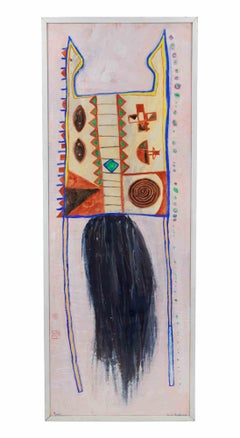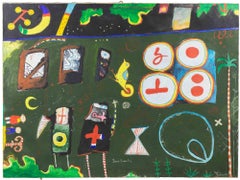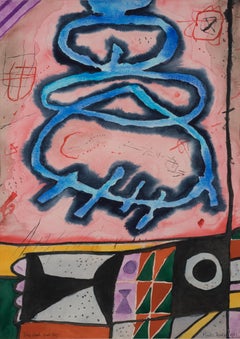Martin Bradley On Sale
1970s Abstract Abstract Drawings and Watercolors
Watercolor
1970s Contemporary Abstract Paintings
Oil, Canvas
1970s Contemporary Abstract Paintings
Canvas, Oil
1980s Contemporary Abstract Paintings
Gouache
Recent Sales
1970s Contemporary Abstract Paintings
Canvas, Ink, Oil
People Also Browsed
2010s British Mid-Century Modern Floor Lamps
Earthenware, Linen, Oak
2010s African Modern Side Tables
Resin, Oak
Mid-20th Century Impressionist Animal Paintings
Oil
2010s Contemporary Landscape Paintings
Canvas, Oil, Handmade Paper
Vintage 1970s Italian Mid-Century Modern Sofas
Fabric, Wood
1980s Contemporary Portrait Paintings
Canvas, Oil, Stretcher Bars
21st Century and Contemporary Figurative Paintings
Oil, Wood Panel
Vintage 1930s French Art Deco Animal Sculptures
Ceramic
2010s American Modern Coffee and Cocktail Tables
Fiberglass
Vintage 1960s American Mid-Century Modern Doors and Gates
Bronze, Steel
2010s American Mid-Century Modern Benches
Linen, Faux Leather
Mid-20th Century French Art Deco Chaise Longues
Bronze
Vintage 1970s German Modern Sofas
Fabric, Upholstery, Foam
Late 20th Century French Space Age Sofas
Suede
1960s Contemporary Figurative Paintings
Oil, Paper, Tempera
21st Century and Contemporary Contemporary Abstract Sculptures
Bronze
Martin Bradley On Sale For Sale on 1stDibs
How Much is a Martin Bradley On Sale?
Martin Bradley for sale on 1stDibs
Martin Bradley was born in 1931. The English painter is best known for abstract and symbolic artworks, influenced by the Japanese and Chinese calligraphy, as well as Buddhism, to which he converted. His name is always associated with travel; while he was traveling in Central and South America, he painted portraits of his shipmates. After his return to England, he studied Oriental languages, literature, and art history and developed a fascination with calligraphy art. During the 1950s, he moved to France, where he came in contact with Rudolphe Augustinci, who was the director of the famous art gallery. In 1978, Marcello Avenali, director of the Academy of Rome introduced him to Tatsuko. In 1979, entering in the ranks of the faithful of Nichiren Shōshū Buddhism, he lived in Mercatale in Val di Pesa, in the Chianti region (Tuscany, Italy) and signed a contract with Samy Kinge. Today, Bradley's artworks are held in the Tate Gallery collections in London, UK, and the Museum of Modern Art in New York, USA. His artworks have been collected by Sir Barbara Hepworth, Sir Roland Penrose and Sir Herbert Read.
A Close Look at Contemporary Art
Used to refer to a time rather than an aesthetic, Contemporary art generally describes pieces created after 1970 or being made by living artists anywhere in the world. This immediacy means it encompasses art responding to the present moment through diverse subjects, media and themes. Contemporary painting, sculpture, photography, performance, digital art, video and more frequently includes work that is attempting to reshape current ideas about what art can be, from Felix Gonzalez-Torres’s use of candy to memorialize a lover he lost to AIDS-related complications to Jenny Holzer’s ongoing “Truisms,” a Conceptual series that sees provocative messages printed on billboards, T-shirts, benches and other public places that exist outside of formal exhibitions and the conventional “white cube” of galleries.
Contemporary art has been pushing the boundaries of creative expression for years. Its disruption of the traditional concepts of art are often aiming to engage viewers in complex questions about identity, society and culture. In the latter part of the 20th century, contemporary movements included Land art, in which artists like Robert Smithson and Michael Heizer create large-scale, site-specific sculptures, installations and other works in soil and bodies of water; Sound art, with artists such as Christian Marclay and Susan Philipsz centering art on sonic experiences; and New Media art, in which mass media and digital culture inform the work of artists such as Nam June Paik and Rafaël Rozendaal.
The first decades of the 21st century have seen the growth of Contemporary African art, the revival of figurative painting, the emergence of street art and the rise of NFTs, unique digital artworks that are powered by blockchain technology.
Major Contemporary artists practicing now include Ai Weiwei, Cecily Brown, David Hockney, Yayoi Kusama, Jeff Koons, Takashi Murakami and Kara Walker.
Find a collection of Contemporary prints, photography, paintings, sculptures and other art on 1stDibs.
Finding the Right Abstract-paintings for You
Bring audacious experiments with color and textures to your living room, dining room or home office. Abstract paintings, large or small, will stand out in your space, encouraging conversation and introducing a museum-like atmosphere that’s welcoming and conducive to creating memorable gatherings.
Abstract art has origins in 19th-century Europe, but it came into its own as a significant movement during the 20th century. Early practitioners of abstraction included Wassily Kandinsky, although painters were exploring nonfigurative art prior to the influential Russian artist’s efforts, which were inspired by music and religion. Abstract painters endeavored to create works that didn’t focus on the outside world’s conventional subjects, and even when artists depicted realistic subjects, they worked in an abstract mode to do so.
In 1940s-era New York City, a group of painters working in the abstract mode created radical work that looked to European avant-garde artists as well as to the art of ancient cultures, prioritizing improvisation, immediacy and direct personal expression. While they were never formally affiliated with one another, we know them today as Abstract Expressionists.
The male contingent of the Abstract Expressionists, which includes Jackson Pollock, Willem de Kooning and Robert Motherwell, is frequently cited in discussing leading figures of this internationally influential postwar art movement. However, the women of Abstract Expressionism, such as Helen Frankenthaler, Lee Krasner, Joan Mitchell and others, were equally involved in the art world of the time. Sexism, family obligations and societal pressures contributed to a long history of their being overlooked, but the female Abstract Expressionists experimented vigorously, developed their own style and produced significant bodies of work.
Draw your guests into abstract oil paintings across different eras and countries of origin. On 1stDibs, you’ll find an expansive range of abstract paintings along with a guide on how to arrange your wonderful new wall art.
If you’re working with a small living space, a colorful, oversize work can create depth in a given room, but there isn’t any need to overwhelm your interior with a sprawling pièce de résistance. Colorful abstractions of any size can pop against a white wall in your living room, but if you’re working with a colored backdrop, you may wish to stick to colors that complement the decor that is already in the space. Alternatively, let your painting make a statement on its own, regardless of its surroundings, or group it, gallery-style, with other works.




